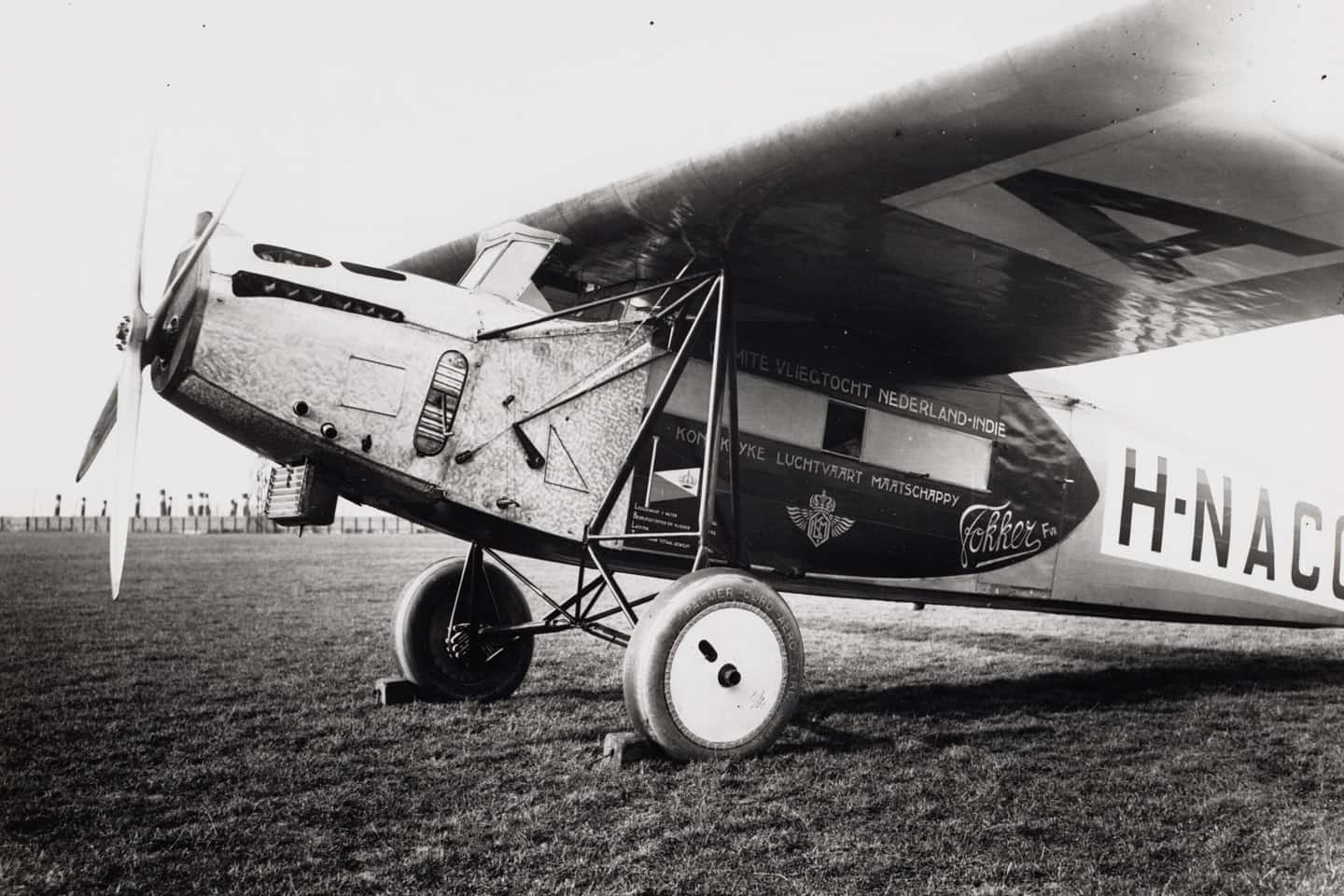Launch of Intercontinental Air Travel
Flying to the other side of the world in the year 2024 is not so much an adventurous journey as an exercise in patience. Things were rather different a century ago. In this blog we take you back in time to the first-ever intercontinental flight from Schiphol, that departed from the airport exactly 100 years ago today.

The racket on board the Fokker F.VII, registration number H-NACC, is deafening. Fortunately, the people inside do not need to worry about the elements thanks to the (at that time) state-of-the-art and fully enclosed cabin they are in. But the noise of the wind blowing along the fuselage of the small plane composed of metal pipes, wood and linen along with the roaring Rolls Royce engine in the nose of the aircraft makes a normal conversation pretty much impossible.
Faster and more economical
KLM pilot Jan Thomassen à Thuessing van der Hoop, flight lieutenant Hendrik van Weerden Poelman (who you can read more about in this blog )and flight engineer Pieter van den Broeke did not embark on this flight just for fun. They have a mission: to prove that flying to the other side of the world is not only possible but, more importantly, faster and therefore more economical than the long journey by boat.
Twenty stops
On 1 October 1924, the three take off from Schiphol full of anticipation and they are waved goodbye by hundreds of interested spectators. The expectation is that they can complete the approximately 15,000-kilometre-long journey to Batavia in the Dutch East Indies (nowadays known as Jakarta and Indonesia) in 22 days. Despite the aircraft being equipped with extra fuel tanks, they must stop about twenty times along the way to refuel and perform maintenance. The three pioneers must depend on what they see on the ground to determine the route.
Skilful
The first two stages (from Schiphol to Prague and then to Belgrade) go well. But on day three things go wrong. The engine gives up the ghost and pilot Van der Hoop barely, but skilfully, manages to ground his plane on a small grass field near the Bulgarian city of Philippopel (now called Plovdiv). The good news is that there were no injuries. But the landing gear and engine are badly damaged, and no money is available to make the necessary repairs.
New engine
The journey is in danger of falling apart before it has properly begun. But Het Leven comes to the rescue. In no time, editors and readers of this weekly collect enough money to pay for a new engine. First it must be transported from the Netherlands by train. It takes a month before the gentlemen can resume their journey at the beginning of November. Fortunately, the journey proceeds without any major problems. After stops in Constantinople (now Istanbul), Aleppo (Syria), Karachi (Pakistan), Calcutta (India) and Rangoon (Burma, now Myanmar), among other places, the men land at Tjililitan airport near Batavia on 24 November, tired but satisfied after a 54-day journey.
Iconic achievement
Mission accomplished? Yes and no. The iconic flight of Van der Hoop, Van Weerden Poelman and Van den Broeke proves that flying to the other side of the world is possible. However, it isn't until 1930 that KLM launches a regular route between the Netherlands and the Dutch East Indies. Nevertheless, with their achievement, the three men (without realising it at the time) have laid the foundation for intercontinental air travel as we know it today.
Royal decoration
The magnitude of the three pioneers' feat does not escape the general public. Once on the ground, Van der Hoop and Van Weerden Poelman immediately receive royal decoration. Van den Broeke, as a simple mechanic at a time when rank and file still had great significance, has to make do with a gold medal. That mistake is not rectified until the 1960s, when he also receives a decoration. And the famous plane used for this historic flight? It is lost less than two years later in a tragic accident near Brussels, Belgium.
Read the previous blogs
-
A day in the life of... a mortuary coordinator
Published on:Did you know that there is a mortuary at Schiphol? In this blog, mortuary coordinator Ben Vos tells us all about the important work he and his colleagues do.

-
New electric buses for P3 Long Term Parking
Published on:Parking for a long period at Schiphol? The free shuttle bus takes you from P3 to the terminal in just 5 minutes. What's more the buses are all electric!

-
Where will you fly to in 2025?
Published on:Will we see you at Schiphol soon to discover new places? Because in 2025 several new destinations will be added to our network.




